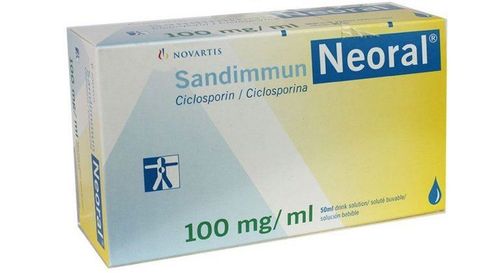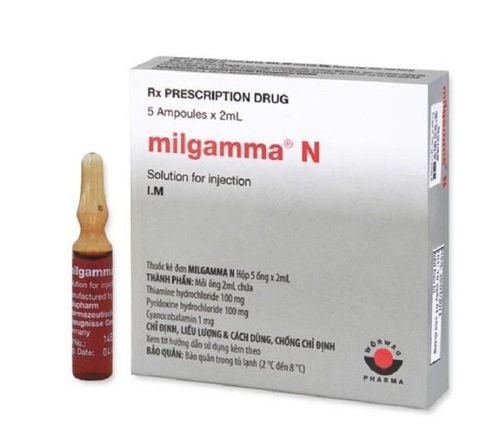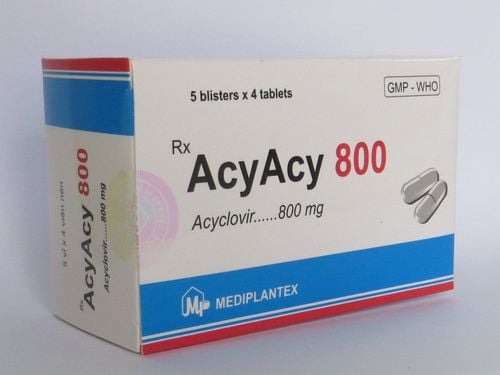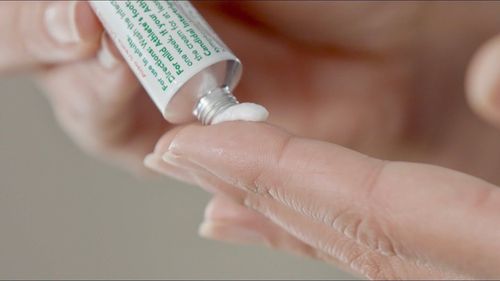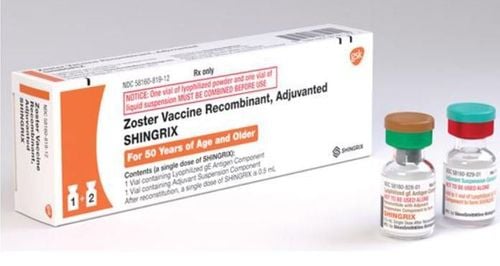This is an automatically translated article.
Agiclovir 800mg is a medicine used to treat infections against bacteria, viruses and fungi effectively, including cases of Herpes simplex virus, Herpes zoster, Varicella zoster,... Drugs for adults and children over 6 years old.
1. What is agiclovir 800?
Pharmacodynamics:
Acyclovir is a synthetic purine nucleoside analogue with in vitro and in vivo inhibitory effects against the human herpes virus.
Pharmacokinetics:
Acyclovir is only partially absorbed from the intestine. The mean steady-state maximal plasma concentration (Cmax) after doses of 200 mg administered every 4 hours was 3.1 micromole (0.7 mcg/mL) and minimum concentration (Cmin) was 1.8 micromoles (0.4 mcg/ml). The corresponding Cmax concentrations after doses of 400 mg and 800 mg administered every 4 hours were 5.3 micromole (1.2 mg/ml) and 8 micromole (1.8 mg/ml), and Cmin was 2.7 micromole, respectively (0). 0.6mg/ml) and 4 micromoles (0.9mg/ml). In adults, the terminal plasma half-life of acyclovir following intravenous administration is approximately 2.9 hours. Most of the drug is eliminated by the kidneys as unchanged drug. Renal clearance is much greater than creatinine clearance, suggesting that tubular secretion along with glomerular filtration contributes to renal elimination. 9-carboxymethylguanine is the only active metabolite of acyclovir and accounts for about 10-15% of the dose recovered in the urine. When acyclovir was administered 1 hour after oral administration of 1 g probenecide, the terminal half-life and AUC increased by 18% and 40%, respectively. In adults, Cmax concentrations after infusion within 1 hour of 2.5 mg/kg, 5 mg/kg, and 10 mg/kg doses were 22.7 micromole (5.1 mcg/ml), 43.6 micromole, respectively. (9.8mcg/ml) and 92 micromoles (20.7mcg/ml). The corresponding Cmin concentrations after 7 hours were 2.2 micromole (0.5mcg/ml), 3.1 micromole (0.7mcg/ml) and 10.2 micromole (2.3mcg/ml). In children over 1 year of age, mean Cmax and Cmin concentrations were also found when 250 mg/m2 was used instead of 5 mg/kg and 500 mg/m2 was substituted for 10 mg/kg. In neonates less than 3 months of age who were treated with doses of 10 mg/kg as an intravenous infusion over 1 hour every 8 hours, the Cmax was found to be 61.2 micromoles (13.8 mcg/ml) and the Cmin to be 10.1 micromoles (2.3 mcg/ml). The terminal half-life in these patients was 3.9 hours. In the elderly, a decrease in total body clearance with age is associated with a decrease in creatinine clearance although there is little change in the terminal plasma half-life. In patients with chronic renal failure, the mean terminal plasma half-life was 19.5 hours. The half-life in hemodialysis for acyclovir is 5.7 hours. Plasma concentrations of acyclovir are reduced to approximately 60% during dialysis. Concentrations in the cerebrospinal fluid are approximately 50% of the corresponding plasma concentrations. Binding of the drug to plasma proteins is relatively low (9-33%) and drug interactions involving substitution at the binding site are not anticipated. Acyclovir as an ophthalmic ointment is rapidly absorbed through the corneal epithelium and surface tissues of the eye, resulting in concentrations that are toxic to the virus in the aqueous humor. Acyclovir could not be detected in the blood by current methods following topical application of Acyclovir ophthalmic ointment, however quantitative traces of the drug could be detected in the urine. However, these concentrations are not therapeutically significant. Teratogenicity: Systemic administration of acyclovir in assays according to internationally accepted standards did not induce fetal toxicity and was not teratogenic in rabbits, adult rats and mice. Effects on Fertility: Widely reversible adverse effects on spermatogenesis associated with total toxicity in rats and dogs have been reported to occur only with greatly exceeded amounts of acyclovir. dosages used for treatment. Two-generation studies in rats have shown no effect of oral acyclovir on fertility. In humans, no effect on fertility has been observed with acyclovir in women. Acyclovir tablets have shown no definite effect on sperm count, morphology and motility in humans.
2. Uses of Agiclovir 800
Acyclovir is a nucleoside analogue (acycloguanosin), which has a selective effect on cells infected with the Herpes virus. To be effective, acyclovir must be phosphorylated to the active form acyclovir triphosphate. In the first step, acyclovir is converted to acyclovir monophosphate by the viral enzyme thymidinekinase, and then to acyclovir diphosphate and triphosphate by several other cellular enzymes. Acyclovir triphosphate inhibits viral DNA synthesis and viral replication without affecting normal cellular metabolism. The effect of acyclovir is strongest on Herpes simplex virus type 1 (HSV - 1) and less effective on Herpes simplex virus type 2 (HSV - 2), Varicella zoster virus (VZV), weakest effect on cytomegalovirus (CMV). Clinically, acyclovir has not been found to be effective in patients with CMV infection. The effect against Epstein Barr virus is still unknown. During the treatment, some drug-resistant strains appeared, and the latent Herpes simplex virus in the lymph nodes was not destroyed. Acyclovir has good effect in the treatment of severe encephalitis caused by HSV-1 virus, the mortality rate can be reduced from 70% to 20%. In some patients who are cured, serious complications are also reduced. Acyclovir is used in doses as high as 10 mg/kg body weight every 8 hours for 10 to 14 days. Milder forms of encephalitis due to HSV-2 can also be treated well with acyclovir. In critically ill patients, intravenous acyclovir is required, e.g. disseminated HSV infection in immunocompromised patients, organ transplant recipients, haematological malignancies, AIDS, primary oral or genital herpes, neonatal herpes severe keratitis caused by Herpes, this case can be used with acyclovir 3% eye drops for local treatment.
3. Indications and contraindications of Agiclovir 800mg
Indications:
*Tablets: Herpes simplex virus infections of the skin and mucous membranes, including genital herpes with onset and recurrence. Prevention of reinfection with herpes simplex in immunocompetent individuals.
Prophylaxis of herpes simplex in immunocompromised patients.
Shingles (herpes zoster). Studies show that early treatment of shingles with acyclovir has a beneficial effect on pain perception and may reduce the frequency of postherpetic neuralgia (pain associated with shingles).
*Cream: Herpes simplex cutaneous viral infections including lip herpes and genital herpes, onset and recurrence.
*Ophthalmic ointment: herpes simplex keratitis.
Contraindications:
Patients with known hypersensitivity to Acyclovir. Cream: Hypersensitivity to propyleneglycol.
4. Dosage - how to use agiclovir 800
Tablets:
Treatment of herpes simplex in adults:
For the treatment of herpes simplex infections, 200mg of Acyclovir should be taken 5 times a day about 4 hours apart to avoid having to take it at night. Treatment is possible within 5 days, but may take longer for severe onset viral infections. In severely immunocompromised patients (e.g. after bone marrow transplantation) or in patients with reduced intestinal absorption, the dose may be doubled to 400 mg or may be altered by considering intravenous administration. . Treatment should be started as soon as possible after infection; For recurrent episodes, therapy should be applied during the prodromal phase or at the onset of the lesion. Suppression of herpes simplex in adults: for the prevention of herpes simplex infection in immunocompetent patients, 200 mg of Acyclovir should be administered 4 times daily at approximately 6 hourly intervals. Many patients find it convenient to take 400 mg twice daily about 12 hours apart. Reducing the dose to 200mg 3 times a day at 8 hour intervals or even twice a day at about 12 hours can also be effective. Some patients may develop a sudden infection with a total daily dose of 800mg. Treatment should be stopped every 6-12 months to observe possible changes in the natural course of the disease. Prevention of herpes simplex in adults: for the prevention of herpes simplex in immunocompromised patients, 200 mg of acyclovir should be administered 4 times daily at approximately 6 hourly intervals. In patients who are severely immunocompromised (e.g. after bone marrow transplantation) or have impaired intestinal absorption, the dose may be doubled to 400 mg or a change to intravenous administration may be considered. The duration of preventive medication depends on whether the period at risk is long or short. Treatment of shingles (herpes zoster) in adults:
For the treatment of shingles (herpes zoster), it is recommended to take 800mg of Acyclovir 5 times daily about 4 hours apart, without having to take it at night. Should be treated within 7 days. For patients who are severely immunocompromised (e.g. after bone marrow transplantation) or have impaired intestinal absorption, intravenous administration should be considered. Should be started as soon as possible after infection; Treatment is most effective if started at the onset of the rash. Dosage for children:
For the treatment of herpes simplex in immunocompromised patients, children over 2 years of age should take the adult dose and children under 2 years of age should take half the dose for adults. Adults. There are no specific data on preventing herpes simplex infection or treating shingles (herpes zoster) in immunocompetent children. Elderly: In the elderly, total body clearance of acyclovir decreases in parallel with creatinine clearance. Rehydration should be maintained for patients receiving high doses of acyclovir. Particular attention should be paid to dose reduction in patients with renal impairment. Renal Impairment: In the management of herpes simplex infection in patients with renal impairment, the recommended oral dose does not lead to accumulation of acyclovir above levels determined to be safe when administered intravenously. However, in patients with severe renal impairment (creatinine clearance less than 10 mL/min) the dose should be adjusted to 200 mg twice daily at approximately 12 hourly intervals. In the treatment of shingles (herpes zoster), 800 mg twice daily at approximately 12-hour intervals for patients with severe renal impairment (creatinine clearance less than 10 mL/min) and 800 mg three times daily at approximately 8-hour intervals for patients with moderate renal impairment (creatinine clearance between 10-25ml/min). Acyclovir cream:
For adults and children, should be applied 5 times a day about 4 hours apart, do not use at night. Acyclovir cream should be applied to the lesion or the site of the impending lesion as soon as possible after infection. Treatment of recurrent episodes is especially important to begin during the prodromal phase or as soon as lesions begin to appear. Treatment should be continued for 5 days. If not healed, treatment can be extended up to 10 days. Acyclovir ophthalmic ointment:
For adults and children, put a squeeze amount of medicine about 10mm into the sac and conjunctiva, 5 times a day, about 4 hours apart. Treatment should be continued for at least 3 days after healing.
5. Side effects of Agiclovir 800
Tablets:
Skin rashes have been reported in some patients using the tablets and resolved spontaneously upon discontinuation of the drug. Gastrointestinal effects such as nausea, vomiting, diarrhea and abdominal pain have been reported in patients receiving tablets. In double-blind, placebo-controlled trials, the frequency of gastrointestinal disturbances was not found to be significantly different between the placebo and acyclovir groups. Reversible neurological reactions, notably dizziness, confusion, hallucinations and somnolence have been reported occasionally, usually in patients with renal impairment or predisposing factors. sick. A few reports of increased diffuse alopecia areata. Because this type of illness is often associated with multiple drugs and different disease processes, the relationship between this presentation and acyclovir therapy is uncertain. There are also very rare cases that have been reported in patients taking acyclovir including mild and transient elevations of bilirubin and liver enzymes, slight increases in blood urea and creatinine, slight decrease in hematological parameters, headache, Reversible mild neurological reactions and fatigue. Cream: A burning and stinging sensation may occur in some patients when applying the drug. Rash or pruritus has also been reported in a small number of patients.
Ophthalmic ointment: in a small number of patients, a transient stinging sensation may occur immediately after application of the drug to the eye. Superficial microscopic keratopathy has also been reported. This sign does not necessitate early discontinuation of the drug and will heal without obvious complications.
Local irritation and inflammation, such as blepharitis and keratitis, have been reported in patients receiving Acyclovir ophthalmic ointment.
Please dial HOTLINE for more information or register for an appointment HERE. Download MyVinmec app to make appointments faster and to manage your bookings easily.




